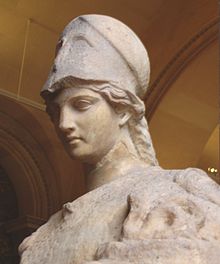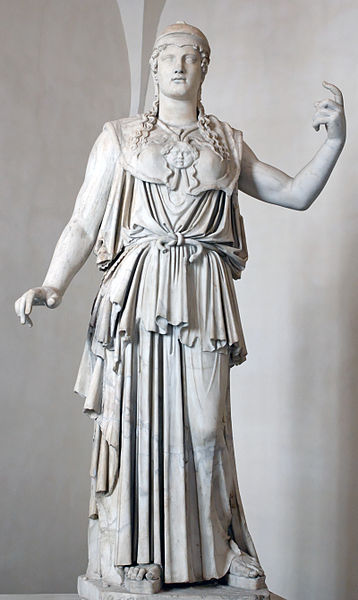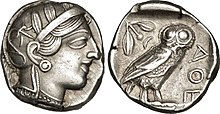|
Greek city of
Mesembria
in Thrace
Bronze 10mm (1.30 grams) Struck 350-200 B.C.
Reference: SNGBMC 278; SNG BMC Black Sea 278; Moushmov 3977
Helmeted head of
Athena
right.
META in the four quarters of a wheel.
An important colony of Megara, Mesembria was situated on the Black Sea coast,
north of Apollonia Pontika.
You are bidding on the exact item pictured,
provided with a Certificate of Authenticity and Lifetime Guarantee of
Authenticity.

Helmeted Athena with the cista and Erichthonius in his serpent form.
Roman, first century (Louvre
Museum)
In
Greek religion
and
mythology
, Athena or Athene, also
referred to as Pallas Athena/Athene , is the goddess of wisdom, courage,
inspiration, civilization, law and justice, just warfare, mathematics, strength,
strategy, the arts, crafts, and skill.
Minerva
is the
Roman goddess
identified with
Athena.

Athena is also a shrewd companion of
heroes and is the
goddess
of heroic endeavour. She is the
virgin
patroness of
Athens
. The Athenians founded the
Parthenon
on the Acropolis of her namesake
city, Athens (Athena Parthenos), in her honour.
Athena’s veneration as the patron of Athens seems to have existed from the
earliest times, and was so persistent that archaic myths about her were recast
to adapt to cultural changes. In her role as a protector of the city (polis),
many people throughout the Greek world worshiped Athena as Athena Polias
(Ἀθηνᾶ Πολιάς “Athena of the city”). The city of
Athens
and the goddess Athena essentially bear
the same name, “Athenai” meaning “[many] Athenas”.
Patroness

Athenian
tetradrachm
representing the
goddess Athena
Athena as the goddess of philosophy became an aspect of the cult in Classical
Greece during the late 5th century B.C. She is the patroness of various crafts,
especially of weaving
, as Athena Ergane, and was
honored as such at festivals such as
Chalceia
. The metalwork of weapons also fell
under her patronage. She led battles (Athena
Promachos or the warrior maiden Athena Parthenos) as the
disciplined, strategic side of war, in contrast to her brother
Ares, the patron of violence, bloodlust and slaughter—”the raw force
of war”. Athena’s wisdom includes the cunning intelligence (metis) of
such figures as Odysseus
. Not only was this version of Athena
the opposite of Ares in combat, it was also the polar opposite of the serene
earth goddess version of the deity, Athena Polias.
Athena appears in Greek mythology as the patron and helper of many heroes,
including Odysseus
,
Jason
, and
Heracles
. In
Classical Greek
myths, she never consorts with
a lover, nor does she ever marry,earning the title Athena Parthenos. A
remnant of archaic myth depicts her as the adoptive mother of
Erechtheus
/Erichthonius
through the foiled rape by
Hephaestus
. Other variants relate that
Erichthonius, the serpent that accompanied Athena, was born to
Gaia
: when the rape failed, the semen landed on
Gaia and impregnated her. After Erechthonius was born, Gaia gave him to Athena.
Though Athena is a goddess of war strategy, she disliked fighting without
purpose and preferred to use wisdom to settle predicaments.The goddess only
encouraged fighting for a reasonable cause or to resolve conflict. As patron of
Athens she fought in the Trojan war on the side of the Achaeans.
Mythology
Lady of Athens
Athena competed with
Poseidon
to be the patron deity of Athens,
which was yet unnamed, in a version of one
founding myth
. They agreed that each would give
the Athenians one gift and that the Athenians would choose the gift they
preferred. Poseidon struck the ground with his
trident
and a salt water spring sprang up; this
gave them a means of trade and water—Athens at its height was a significant sea
power, defeating the
Persian
fleet at the
Battle of Salamis
—but the water was salty and
not very good for drinking.
Athena, however, offered them the first domesticated
olive tree
. The Athenians (or their king,
Cecrops
) accepted the olive tree and with it
the patronage of Athena, for the olive tree brought wood, oil, and food.
Robert Graves
was of the opinion that
“Poseidon’s attempts to take possession of certain cities are political myths”
which reflect the conflict between matriarchal and patriarchal religions.
Other sites of cult
Athena also was the patron goddess of several other Greek cities, notably
Sparta, where the archaic cult of
Athena Alea
had its sanctuaries in the
surrounding villages of
Mantineia
and, notably,
Tegea
. In Sparta itself, the temple of Athena
Khalkíoikos (Athena “of the Brazen House”, often
latinized
as Chalcioecus) was the
grandest and located on the Spartan acropolis; presumably it had a roof of
bronze. The forecourt of the Brazen House was the place where the most solemn
religious functions in Sparta took place.
Tegea was an important religious center of ancient Greece, containing the
Temple of Athena Alea
. The temenos was founded by
Aleus
,
Pausanias
was informed. Votive bronzes at the
site from the Geometric and Archaic periods take the forms of horses and deer;
there are
sealstone
and
fibulae
. In the Archaic period the nine
villages that underlie Tegea banded together in a
synoecism
to form one city. Tegea was listed in
Homer
‘s
Catalogue of Ships
as one of the cities that
contributed ships and men for the
Achaean assault on Troy
.
Judgment of Paris

Aphrodite is being surveyed by Paris, while Athena (the leftmost
figure) and Hera stand nearby.
El Juicio de Paris
by
Enrique Simonet
, ca. 1904
All the gods and goddesses as well as various mortals were invited to the
marriage of Peleus
and
Thetis
(the eventual parents of
Achilles
). Only
Eris
, goddess of discord, was not invited. She
was annoyed at this, so she arrived with a golden apple inscribed with the word
καλλίστῃ (kallistēi, “for the fairest”), which she threw among the goddesses.
Aphrodite, Hera, and Athena all claimed to be the fairest, and thus the rightful
owner of the apple.
The goddesses chose to place the matter before Zeus, who, not wanting to
favor one of the goddesses, put the choice into the hands of Paris, a
Trojan prince. After bathing in the spring of
Mount Ida
(where Troy was situated), the
goddesses appeared before Paris. The goddesses undressed and presented
themselves to Paris naked, either at his request or for the sake of winning.

Paris is awarding the apple to Aphrodite, while Athena makes a face.
Urteil des Paris by
Anton Raphael Mengs
, ca. 1757
Still, Paris could not decide, as all three were ideally beautiful, so they
resorted to bribes. Hera tried to bribe Paris with control over all
Asia and Europe
, while Athena offered wisdom, fame and
glory in battle, but Aphrodite came forth and whispered to Paris that if he were
to choose her as the fairest he would have the most beautiful mortal woman in
the world as a wife, and he accordingly chose her. This woman was
Helen
, who was, unfortunately for Paris,
already married to King
Menelaus
of
Sparta
. The other two goddesses were enraged by
this and through Helen’s abduction by Paris they brought about the
Trojan War
.

The Parthenon
, Temple of Athena
Parthenos
Masculinity and
feminism
Athena had an “androgynous compromise” that allowed her traits and what she
stood for to be attributed to male and female rulers alike over the course of
history (such as Marie de’ Medici, Anne of Austria, Christina of Sweden, and
Catherine the Great)
J.J. Bachofen advocated that Athena was originally a maternal figure stable
in her security and poise but was caught up and perverted by a patriarchal
society; this was especially the case in Athens. The goddess adapted but could
very easily be seen as a god. He viewed it as “motherless paternity in the place
of fatherless maternity” where once altered, Athena’s character was to be
crystallized as that of a patriarch.
Whereas Bachofen saw the switch to paternity on Athena’s behalf as an
increase of power, Freud on the contrary perceived Athena as an “original mother
goddess divested of her power”. In this interpretation, Athena was demoted to be
only Zeus’s daughter, never allowed the expression of motherhood. Still more
different from Bachofen’s perspective is the lack of role permanency in Freud’s
view: Freud held that time and differing cultures would mold Athena to stand for
what was necessary to them.
Nesebar Mesimvria, previously known as Mesembria;
other spellings include Nessebar and Nesebur) is an ancient city
and a major seaside resort on the
Black Sea
coast of Bulgaria
, located in
Nesebar municipality
,
Burgas Province
. Often referred to as the “Pearl of the Black Sea”
and “Bulgaria’s
Dubrovnik
“,
Nesebar is a rich city-museum defined by more than three millennia of
ever-changing history.
It is a one of the most prominent tourist destinations and
seaports on the Black Sea, in what has become a popular area with several large
resorts—the largest,
Sunny
Beach
, is situated immediately to the north of Nesebar.
Nesebar has on several occasions found itself on the frontier
of a threatened empire, and as such it is a town with a rich history. The
ancient part of the town is situated on a peninsula (previously an island)
connected to the mainland by a narrow man-made
isthmus
, and
it bears evidence of occupation by a variety of different civilisations over the
course of its existence. Its abundance of historic buildings prompted
UNESCO
to
include Nesebar in its list of
World Heritage Sites
in 1983.
Originally a
Thracian
settlement known as Menebria, the town became a
Greek colony
when settled by
Dorians
from
Megara
at the
beginning of the 6th century BC, and was an important trading centre from then
on and a rival of Apollonia (Sozopol).
It remained the only
Doric colony
along the Black Sea coast, as the rest were typical
Ionic
colonies.
Remains from the
Hellenistic
period include the
acropolis
,
a temple of Apollo
,
and an agora
. A
wall which formed part of the fortifications can still be seen on the north side
of the peninsula. Bronze and silver coins were minted in the city since the 5th
century BC and gold coins since the 3rd century BC.
The town fell under
Roman
rule in 71 BC, yet continued to enjoy privileges such as the right to mint its
own coinage. It was one of the most important strongholds of the
Byzantine Empire
from the 5th century AD onwards, and was fought over by
Byzantines
and
Bulgarians
,
being captured and incorporated in the lands of the
First Bulgarian Empire
in 812 by
Khan Krum
after a two week siege only to be ceded back to Byzantium by Knyaz
Boris I
in 864 and reconquered by his son Tsar
Simeon the Great
. During the time of the
Second Bulgarian Empire
it was also contested by Bulgarian and Byzantine
forces and enjoyed particular prosperity under Bulgarian tsar
Ivan Alexander
(1331–1371) until it was conquered by
Crusaders
led by
Amadeus VI, Count of Savoy
in 1366. The Slavic[
neededcitation] version of the name, Nesebar or Mesebar, has
been attested since the 11th century.
Monuments from the
Middle
Ages
include the 5–6th century Stara Mitropoliya (“old bishopric”;
also
St Sophia
), a
basilica
without a transept
; the 10th century
church of the Virgin
; and the 11th century Nova Mitropoliya (“new
bishopric”; also
St Stephen
) which continued to be embellished until the 18th century. In the
13th and 14th century a remarkable series of churches were built:
St Theodore
,
St Paraskeva
,
St Michael St Gabriel
, and
St John Aliturgetos
.
The capture of the town by the
Turks
in 1453 marked the start of its decline, but its architectural
heritage remained and was enriched in the 19th century by the construction of
wooden houses in style typical for the
Bulgarian Black Sea Coast
during this period. It was a kaza centre in
İslimye
sanjak
of
Edirne Province
before 1878[1].
After the
Liberation of Bulgaria
from Ottoman rule in 1878, Nesebar became part of the
autonomous Ottoman province of Eastern Rumelia as a kaza centre in
Burgaz
sanjak
until it
united
with the Principality of Bulgaria in 1886.
Around the end of the 19th century Nesebar was a small town
of Greek
fishermen and vinegrowers, but developed as a key Bulgarian seaside resort since
the beginning of the 20th century. After 1925 a new town part was built and the
historic Old Town was restored.
|














